BAFA © 2010. All material here is copyrighted. See conditions above. |
Janita Appa
visual arts, multi-media performance, theatre, U.K.
|
In 2002 I completed an MA in devised performance, at the Central School of Speech and Drama, in London, which has motivated me to extend and further develop
my ideas regarding
my own art practice.
My work ranges from multi-media performance to photography, drawing, installation and paintings. The pieces featured here were part of my degree show, on a BA Fine Art (painting and printmaking) and Dance course. The exhibition included works on paper and tracing paper and two installations.
|

Photo: 2000 |
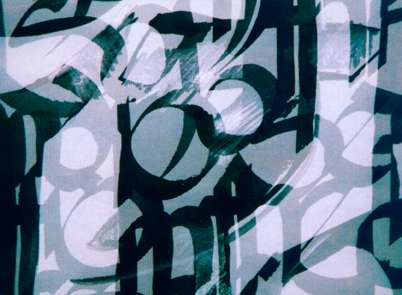
|
Detail of text projection: Projected Self.
Letters from the Hidden Words by Bahá'u'lláh blend into each.
My work deals with explorations of our self-identity and our degrees of attachment or detachment from self.
It refers to graphology and its analysis of character by the use of handwriting as a visual metaphor for an individual statement and a unique expression of personality a personal mark, which no one in the world can replicate.
|
The paintings are intended to be sites on which to meditate. Fields of repetitive calligraphic writing that appear distinctly, as well as merge into the flooded ink background to provoke thought in the viewer.
" Free thyself from the fetters of this world and loose thy soul from
the prison of self"
Bahá'u'lláh
This text from the Hidden Words of Bahá'u'lláh is one of those used in the work. The repetitive obsessive writing of these quotes symbolises a reaffirming of self that simultaneously contradicts the meaning of the words being written.
The installations further extend these ideas to incorporate the body of the spectator. One involved the use of my handwriting cut out of vinyl, following a line around the space at eye level and the other an interactive projection in a corridor.
|

Detail of an installation of words from the Hidden Words by Bahá'u'lláh
painted on a wall.
|

|
This piece developed the theme of layered text in my work by projecting enlarged lettering shapes painted on windows onto a mural of handwriting. The projected image moved across the space according to the position of the sun, only covering the exact area at a certain time of day. Sensors responding to viewers entering at either end of the corridor triggered floodlights positioned outside, adding another layer to the image.
The location allowed the installation to become part of the everyday environment, projecting onto passers-by, whose curiosity would be aroused as they attempted to read the text and unravel the meaning.
|
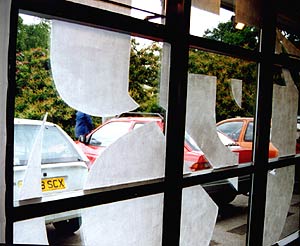 Detail of an installation of words from the
Detail of an installation of words from the
Hidden Words by Bahá'u'lláh.
|
Arts Dialogue, October 2000, pages 4 - 5
|
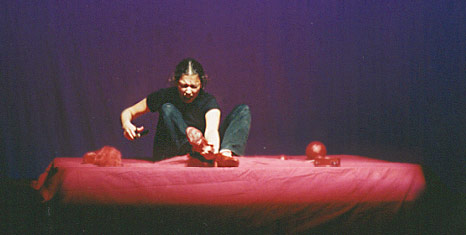
Janita Appa in The Autistic Shoe, 2000.
| The Autistic Shoe - A devised piece of visual theatre
by Janita Appa, U.K.
After completing my studies at the Central School of Speech and Drama, London, my experience has included a part in the feature film "Whatever Happened to Harold Smith", parts in several short films and a variety of theatre performances.
|
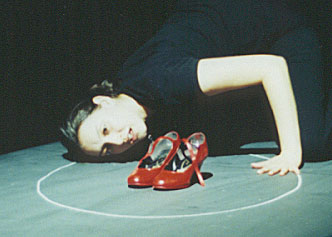
The most exciting and challenging project has been "The Autistic Shoe", a devised piece of theatre performed at the Institute of Contemporary Art, London, last July.
When I met Ruth Wells, my director, at the initial audition, I had little knowledge of autism, so the period of research that followed was particularly intense. Ruth had previously worked in a community home with adults diagnosed as being on the autistic spectrum. She commented on her experience: "The longer I worked there the more I longed to know what went on beyond the eyes; what whirred in those minds. For the world of the autistic seemed very different to mine."
It was this experience that was the inspiration for the piece.
The plan was to devise a piece about autism that would raise awareness and address preconceptions. During our month-long rehearsal, Ruth and I visited a residential home for people with Autism and Asperger's Syndrome. While there we spent time playing, talking, interviewing and observing. This visit was our inspiration, forming the basis of our research, which developed into the writing and choreographing of an hour-long performance.
|
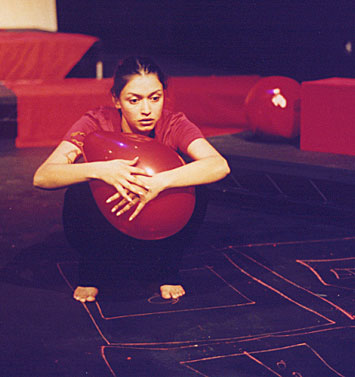
Using the fairytale of "The Red Shoes" as our framework, we set about drawing parallels between the constraints and rules of the autistic world and those imposed upon the little girl in the story. Do we impose too many rules on people with autism? In order for them to fit in with our world we attempt to make them conform rather than allowing them their rights and freedom. Is this correct? Is their world not as valid as ours?
Utilising techniques of physical and visual theatre, we wrote a piece that incorporated movement, text, music and visual metaphor. We created the character, Angela, and her world was red. As she puts it: "Red is warmth. Red is bright. Red is bold. Red is real. Red is your world. Red is my world. Red is babygrow before you decided I was wrong. Red is baubles at Christmas. Red is all the numbers balanced and equated. Red is E equalling mc squared. Red is paper for birthdays and birthdates for infinity. Red is sunset. Red is apples. Red is Edam cheese. Red is velvet. Red is deep. Red is blood. Red is the dawning of me in your world".
Angela was a high functioning autistic. She had to be or she would not have been prepared to face the audience. The audience met her in the world of the fairytale, our other world; that place between the autistic world and our own. As theatre practitioners we set about exploring and experiencing that different world, provoking and questioning along the way. Our intention was not to find the answers or to change an audience's viewpoint but rather to hold up certain opinions to the light for all to see.
There are many people like Angela who live locally to us but whom we never meet. Autistic people have to some extent become invisible people within society and it was therefore our greatest pleasure to let an audience meet Angela and experience her world.
Arts Dialogue, June 2002, pages 2 and 3.
|

Arts Dialogue, Dintel 20, NL 7333 MC, Apeldoorn, The Netherlands
email: bafa@bahai-library.com
|
|




 Detail of an installation of words from the
Detail of an installation of words from the 

